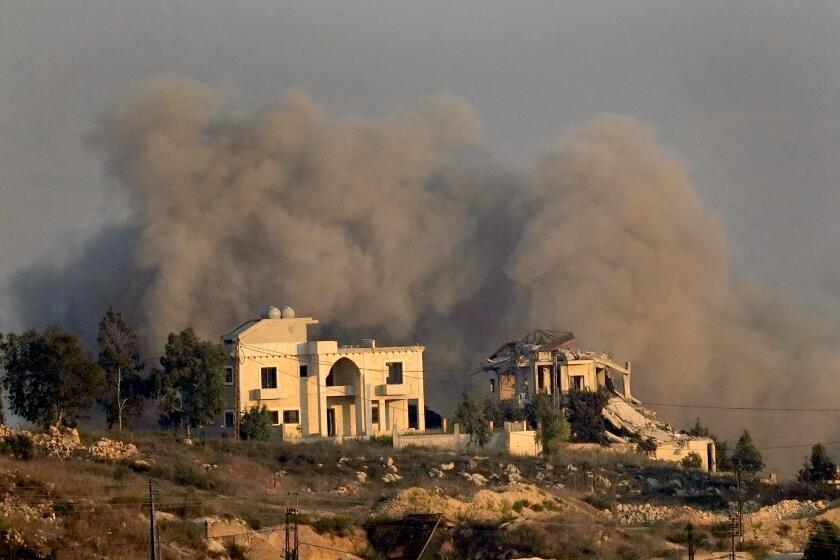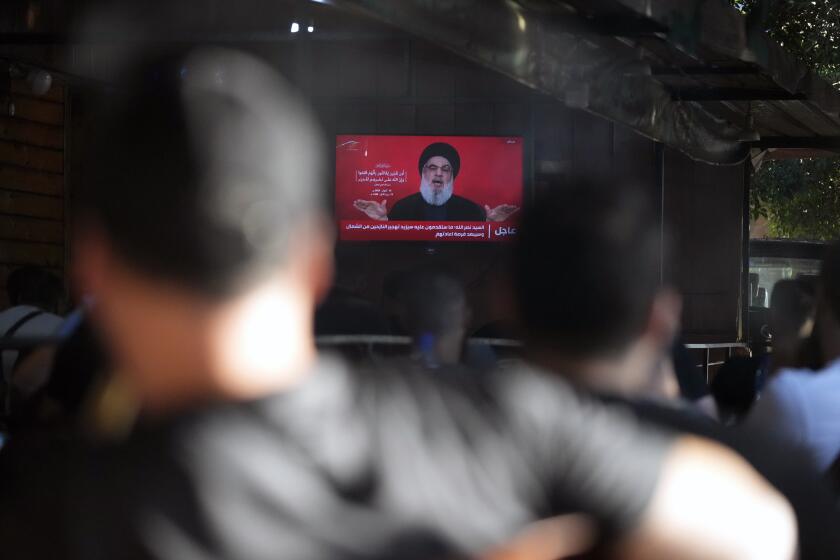
- Share via
BEIRUT — Israel’s sharp escalation against the Lebanese Shiite group Hezbollah has killed hundreds of people, injured thousands and left an estimated half a million displaced, Lebanese authorities say. The violence has spiked fears of a full-on regional conflict, one that would embroil Iran and the U.S.
Whether that happens could depend heavily on the so-called Axis of Resistance, an Iran-backed coalition of governments and paramilitary groups spanning Lebanon, Gaza, Iraq, Syria and Yemen that see the U.S. and Israel as a common enemy.
Since the outbreak of the Israel-Hamas war nearly a year ago, the groups have forced Israel to contend with multiple low-level fronts even as it pursues its main battle in Gaza.
Leaders of the militant groups have said they will suspend their campaign if a ceasefire takes hold in Gaza. But an all-out conflagration with Hezbollah could trigger a more intense response.
Here’s a closer look at the Axis of Resistance.
How did the axis start?
The idea crystallized during Syria’s civil war around 2011, when Iran — which already had close ties with Syria and helped establish Hezbollah in the ‘80s — pushed the Lebanese group to send its veteran fighters to bolster the flagging forces of Syrian President Bashar Assad.
As the Syrian war continued, other groups established or assisted by the Iranian Revolutionary Guard Corps were integrated into the alliance.
Hezbollah, the Lebanese Shiite militant group backed by Iran, appears to have hit the lowest point in its more than 40-year history.
The name is a bit of a play on President George W. Bush’s “axis of evil,” a term he used in 2002 in reference to Iran, Iraq and North Korea.
Some of the militias in Iraq were already calling themselves “the Islamic Resistance.” Axis of Resistance emerged as a more formal entity in more recent years.

Who is part of the axis?
Iran of course.
Aside from Hezbollah, it also includes a number of Iraqi and Syrian militias, along with the Syrian government.
Yemen’s Houthi rebels joined after receiving substantial Iranian help when they fought in 2015 against a Saudi-backed coalition.
Also part of the alliance is Palestinian Islamic Jihad, based primarily in Gaza.
Hamas is one of the more recent additions, joining after Iran brokered a reconciliation between the militant group and Assad.
How big of a fighting force is it?
Numbers are hard to come by.
Before last week’s attacks, Hezbollah was widely considered one of the world’s best-organized and most well-equipped paramilitary groups. It was thought to have some 100,000 fighters, according to statements from Hezbollah leaders in years past. This year, the CIA Factbook put its strength at around 50,000, though it’s unclear how many of those are reservists.
Estimates as to the number of rockets and missiles in the group’s arsenal range from 120,000 to 200,000, including guided and unguided munitions. It also possesses a number of tanks, APCs and other armored vehicles.
It has demonstrated more sophisticated weapons in recent months, including kamikaze drones and longer range projectiles.
Hezbollah leader says Israel crossed all “red lines” with two-day wave of electronic device explosions in Lebanon.
On Wednesday, it used a ballistic missile for the first time to strike Tel Aviv, some 70 miles away from its positions on the Lebanese-Israeli border. Hezbollah said it was targeting the headquarters of Israel’s intelligence service, the Mossad.
Some of the more advanced arms and designs come from Iran, but experts say the group has design and manufacturing capability of its own.
Israel claims a significant portion of that arsenal was destroyed in recent attacks.
Yemen’s Houthis use arms taken from Yemeni government forces stockpiles, said Mohammad Basha, a U.S.-based Yemen analyst who specializes in Houthi military affairs.
“When the Houthis seized control of Sanaa in 2014, they got thousands of missiles and rockets,” he said, including Soviet-era Scuds, Grads and Smerch launchers. But they, too, rely on Iran to develop, modify and upgrade existing arms and manufacture drones.
“There’s enough evidence to show the fiberglass and the body of the drones are manufactured inside Yemen,” Basha said. “Other components — the engine, the GPS, etc… — they’re smuggled from other parts of the world such as Germany and China.”
Iraqi and Syrian militias total 67,000, according to the Syrian Observatory for Human Rights, a watchdog monitor. The more sophisticated factions have deployed drones and longer-range missiles.
After almost a year of fighting, Hamas is weakened. Israeli officials say they have killed more than 17,000 militants.
Is the axis a formal agreement of mutual support, like NATO, or more of an informal coalition?
More informal.
Iran is the most powerful player and the organizing force behind the axis, but the various groups nevertheless do maintain their autonomy, said Michael Knights, an expert on Iran-backed militias at the Washington Institute.
He described the alliance as a network of “ideologically compatible partners.”
“A lot of these factions may be willing to hit Israel as hard as they can, but are they doing it because they want to, or because they’re being told to by Iran?,” he said.
“Right now, the key trend is that every group in the Axis of Resistance is looking for their own interests,” he said. “And even Hezbollah is in a really tricky situation. It doesn’t want to die because of decisions made by Hamas.”

How has the axis responded to Gaza?
The primary response came from Hezbollah, which on Oct. 8 began to lob rockets across the border with Israel in what it called a “support front,” intended to relieve pressure on Palestinians in Gaza by forcing Israel to keep troops near its northern border rather than deploy them in the south.
The Israel-Hamas war started Oct. 7, when Hamas attacked southern Israel, killing 1,200 people. Israel has responded with a military assault in Gaza that has killed more than 40,000 Palestinians, Gaza officials estimate.
Others in the axis have also responded to the war in Gaza.
In Yemen, the Houthis began targeting ships believed to be affiliated with Israel in the Red Sea, and launched long-range missiles to attack Israeli ports.
Earlier this week, Israel said it intercepted cruise missiles and drones sent by Iraqi militias.
Earlier this year, after Israel attacked the Iranian Consulate in Damascus and killed military officials, Tehran launched a large-scale missile and drone attack on Israel. It also continues to threaten vengeance for a presumed Israeli assassination of Hamas leader Ismail Haniyeh in Tehran.
How will the axis respond to the growing conflict in Lebanon?
There are mixed messages.
Iranian leaders say Hezbollah should not have to fight alone when Israel receives so much Western support. That is likely to mean Iran would continue to send arms, and Tehran has also regularly dispatched military advisors to aid Hezbollah. But, like their American counterparts, they say they want a diplomatic solution.
At the same time, Iraqi and Syrian groups have intensified their attacks on Israel in recent days, and the Houthis, who have a close relationship to Hezbollah, say they are ready to support Hezbollah with whatever is needed.
More to Read
Sign up for Essential California
The most important California stories and recommendations in your inbox every morning.
You may occasionally receive promotional content from the Los Angeles Times.













